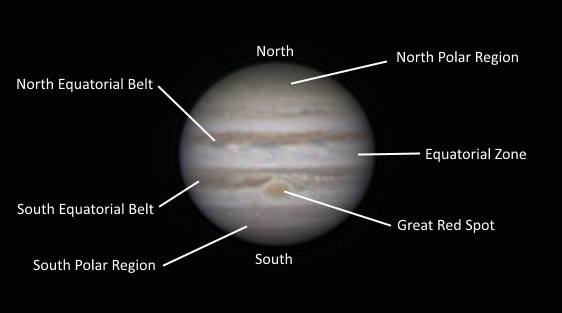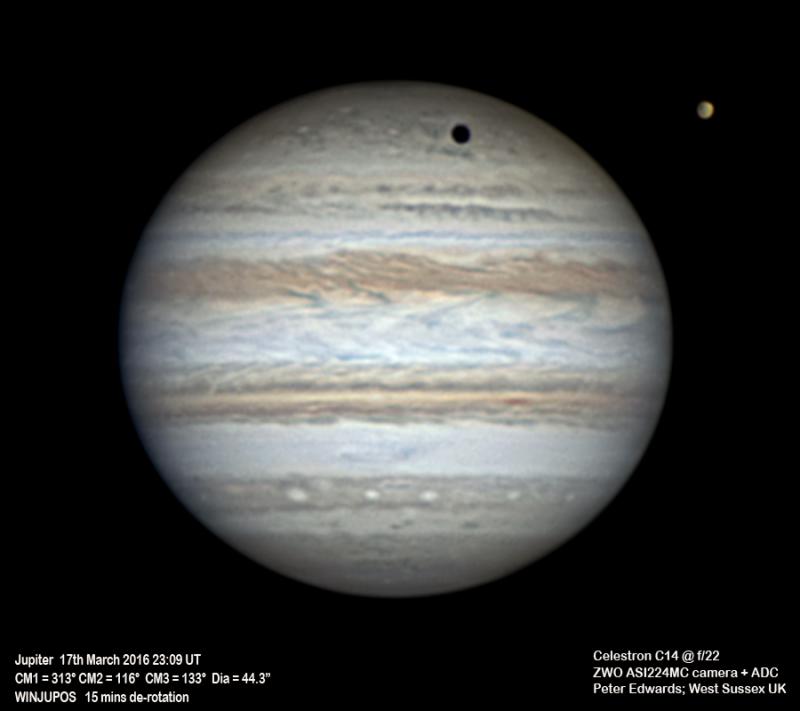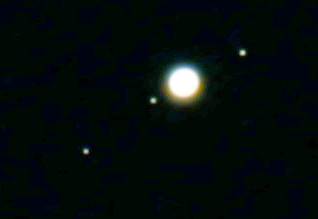2017 March 25
Jupiter and the amateur astronomer

Jupiter is the fifth planet from the Sun and is the largest planet in our solar system. It is the first of the gas and ice giants, the others being Saturn, Uranus and Neptune. Jupiter’s atmosphere is mainly made up of hydrogen (75%) and helium (24%), with the remaining 1% consisting of various heavier elements. The visible stripes are known as belts and zones (see image to the right) and are created by strong alternating bands of winds, called jetstreams, as a result of Jupiter’s rapid rotation. The iconic Great Red Spot is a huge storm larger than the Earth and is possible to observe from your own backyard with even a relatively modest telescope. A more detailed account of Jovian atmospheric activity can be found on the BAA’s Jupiter Section website.
Jupiter has a radius of 69,911 km (43,440 miles) which makes it 11 times wider than the Earth; 1300 Earths would fit within its volume. Jupiter orbits the Sun at an average distance of 778 million km (484 million miles, 5.2 AU), and light takes 43 minutes to reach Jupiter from the Sun; it takes sunlight just over 8 minutes to reach the Earth. The mass of Jupiter is also quite spectacular: it is 2.5 times the mass of all the other planets in the Solar System combined. Jupiter makes a complete orbit around the Sun once every 12 Earth years, though a day on Jupiter is the shortest of any planet in the Solar System, as it spins around its own axis in less than 10 hours!
Jupiter has 79 known natural satellites as of November 2020. The four largest moons – Io, Callisto, Ganymede and Europa – were discovered in 1610 by Galileo Galilei in Italy using an early refractive telescope. These moons are aptly named the “Galilean Moons” and are very interesting bodies. 
Several man-made spacecraft have been sent to Jupiter. Many of these have just been fly-bys, using Jupiter’s gravitational pull to sling-shot and to propel the spacecraft on their journey to other destinations. Galileo was the first to orbit Jupiter with the purpose of exploring Jupiter and its moons and arrived at the planet in 1995 after a 6-year flight. Galileo made many important observations in the eight years it spent orbiting the Jovian system; it made the first detailed recording of the ammonia clouds on Jupiter, and the discovery that Europa, Ganymede and Callisto all harboured water under their surfaces. The most recent spacecraft to orbit Jupiter is Juno, which arrived in July 2016. The continuing mission of Juno is to make further detailed measurements on the composition, gravity field and magnetic field of the planet.
Observing Jupiter

Jupiter is one of the brightest objects in the night sky after the Moon and Venus. As with the planets and the stars it appears to follow a course from the eastern horizon to the western horizon throughout the course of the night.
To help find Jupiter in the sky refer to the BAA Sky Notes or use free planetarium software such as Stellarium.
Observing Jupiter with binoculars will show the planet as a bright blank disc, but if you have keen eyes and can stabilise the binoculars on a wall or use a tripod its moons may appear as faint dots in a line as the image below illustrates. With a small telescope the moons will appear much brighter, and as the aperture of the telescope increases more detail will become apparent on the planet itself. The stripy nature of the planet will be the first thing to notice, and as bigger telescopes are used the detail in these bands becomes greater and even shadows of the moons crossing the face of the planet will appear; when one celestial body crosses in front of another this is referred to as a transit. With telescopes of 8 inches (200mm) and above, observers often report seeing colour. Coloured filters can help bring out detail and improve contrast when observing Jupiter and the other planets. While the eye cannot resolve the detail of Jupiter as clearly as sensitive cameras can, the sense of achievement in observing this mighty planet at the eyepiece cannot be underestimated.
Imaging Jupiter
There are many ways to capture an image of this marvellous planet, from taking a widefield photograph of the planet above the distant horizon, to using dedicated planetary cameras and wide aperture telescopes.

One of the simplest methods to image Jupiter is to hold the camera of a modern smartphone to the eyepiece of a telescope and record the positions of the Galilean Moons, such as that shown to the right.
Using advanced cameras and telescopes with wider aperture, greater detail will appear in the resultant images. One of the biggest hindrances to imaging the planets is the adverse impact the Earth’s atmosphere and our weather has on the transmission of light. Many professional observatories are found at high altitude in an attempt to avoid the effect the weather has on the seeing conditions. For the amateur astronomer the options are to travel to warmer climes where cloud is less likely and the atmosphere is more stable, or to use remote instruments to capture data which is transferred to their own computers via the internet (read the article by Damian Peach on this topic). However, with skill and care, it is possible to record detailed telescopic images from the UK; the time lapse image below was captured from a back garden in Nottingham.

Cameras with the capacity to record video at high frame rates (typically 50-200 frames per second) are now available and within the budget of many amateur astronomers. Relatively short runs of video recording (in the order or 2-3 minutes) can easily capture in excess of 10,000 individual frames of the planet in question. Freely available software such as Registax and Autostakkert! can then be used to sort the frames by quality, and stack the best ones to make a composite image.
Conventionally imaging runs of Jupiter have always needed to be relatively short because of its rapid rotational period, where the rotation of the planet would be inadvertently recorded and result in blurring of the final image. Newer software, notably WinJUPOS, allows the data in longer runs of video to be de-rotated, permitting even greater detail to be depicted in the final composite image.
Despite the average distance between the Earth and Jupiter being about 628 million km (390 million miles), amateur astronomers today can capture amazing detail of this gas giant, observing the changing weather systems, the rotation of the planet and the orbit of its moons.

Drawing Jupiter
Not everyone wants to record the details they observe using a camera. Drawing and sketching is a valuable way to capture details about the planet and positions of its moons – indeed this is how Galileo recorded his findings when he first observed the movement of the four Galilean Moons in relation to Jupiter.
As with astrophotography, almost any telescope can be used when undertaking a drawing, though on the whole the bigger the telescope the more detail that can be seen and recorded. Paul Abel is very skilled at drawing, and the beautiful image to the right shows Jupiter’s full disc, the banding of the planet and of course the Great Red Spot.
Get out there
Jupiter is an amazing sight to see in the night sky, either with the naked eye, or binoculars or a telescope. Watching the positions of its moons change from night to night, and to be able to see and record the banding of the planet as well as identifying the Great Red Spot is all greatly rewarding.
Amateur astronomers continue to make significant contributions to our understanding of this gas giant including the changing nature of the Great Red Spot and during impact events when solar system debris is lured into the gas giant by its huge gravitational pull.
So if you have a telescope and Jupiter is visible in a clear sky do have a look!
————-
Tobias is an undergraduate at The University of Nottingham reading for an MSci in Physics with Theoretical Physics and a member of Nottingham Astronomical Society.
James is an amateur astronomer from Nottingham and a member of Nottingham Astronomical Society.
————-
Phenomena and positional data about Jupiter and its moons (and the other planets) is available in the BAA Handbook, which is free to BAA members and available to purchase from the BAA shop.
To search for observations of Jupiter uploaded by BAA members, following this link to search the BAA Member Pages or to refer to the BAA’s Jupiter Section.
Image used as article thumbnail by Martin Mobberley
| The British Astronomical Association supports amateur astronomers around the UK and the rest of the world. Find out more about the BAA or join us. |
